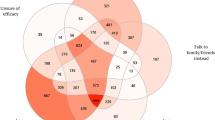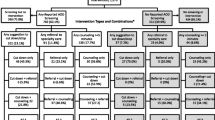Abstract
Purpose
The non-medical use of prescription medications among adolescents has become a concerning public health issue. This study assessed the prevalence of the non-medical use of prescription medications in Ontario high school students, and explored the moderating effect of this use on the relationship between psychological distress and unmet mental health needs.
Methods
Cross-sectional data for 4896 students, age 14–18, were drawn from the 2019 Ontario Student Drug Use and Health Survey. Psychological distress was measured using the Kessler-6 Distress Scale, unmet mental health needs were defined by self-report (yes/no), and non-prescription medication use was defined by self-reported frequency of use. Using logistic regression, we explored the effect of the non-medical use of prescription medications on the relationship between psychological distress and unmet mental health needs.
Results
High proportions of Ontario students reported serious psychological distress (22%), some degree of unmet mental health need (38%), and/or non-medical use of prescription medications (13%). While there were strong associations between psychological distress and unmet mental health need, this association was weaker among those reporting non-medical use of prescription medications (OR = 3.3, 95% CI 1.9–5.7) compared to non-users (OR = 5.6, 95% CI 4.5–7.1).
Conclusion
Our findings suggest that Ontario students experiencing distress and using non-prescribed medications are less likely to identify a need for mental health support, highlighting the consequences of apparent self-medication through misuse of prescription medications. To assist in the redirection of adolescent perceptions of healthy coping strategies, population-based educational programming, with targeted promotion of both formal and informal mental health care resources, should be considered.
Similar content being viewed by others
Data availability
Data can be accessed by contacting the OSDUHS team at osduhs@camh.ca.
References
Twenge JM, Cooper AB, Joiner TE et al (2019) Age, period, and cohort trends in mood disorder indicators and suicide-related outcomes in a nationally representative dataset, 2005–2017. J Abnorm Psychiatry 128:185–199. https://doi.org/10.1037/abn0000410
WHO (2022) Adolescent and young adult health. https://www.who.int/news-room/fact-sheets/detail/adolescents-health-risks-and-solutions.
Wiens K, Bhattarai A, Pedram P et al (2020) A growing need for youth mental health services in Canada: examining trends in youth mental health from 2011 to 2018. Epidemiol Psychiatr Sci 29:e115–e115. https://doi.org/10.1017/S2045796020000281
Gandhi S, Chiu M, Lam K et al (2016) Mental health service use among children and youth in Ontario: population-based trends over time. Can J Psychiatry 61:119–124. https://doi.org/10.1177/0706743715621254
Gardner W, Pajer K, Cloutier P et al (2019) Changing rates of self-harm and mental disorders by sex in youths presenting to Ontario emergency departments: repeated cross-sectional study. Can J Psychiatry 64:789–797. https://doi.org/10.1177/0706743719854070
Drapeau A, Marchand A, Beaulieu-Prevost D (2012) Epidemiology of psychological distress. In: L’Abate L (ed) Mental illnesses - understanding, prediction and control. IntechOpen, Rijeka, pp 105–134
Cuijpers P, Smits N, Donker T et al (2009) Screening for mood and anxiety disorders with the five-item, the three-item, and the two-item mental health inventory. Psychiatry Res 168:250–255. https://doi.org/10.1016/j.psychres.2008.05.012
Ratnashingham S, Cairney J, Rehm J, et al (2012) Opening eyes, opening minds: the Ontario burden of mental illness and addictions report, Toronto.
Bartram M (2017) Making the most of the federal investment of $5 billion for mental health. CMAJ 189:E1360–E1363. https://doi.org/10.1503/cmaj.170738
OCED (2014) Making mental health count: the social and economic costs of neglecting mental health care. OECD Publishing
Moroz N, Moroz I, D’Angelo MS (2020) Mental health services in Canada: barriers and cost-effective solutions to increase access. Healthc Manag Forum 33:282–287. https://doi.org/10.1177/0840470420933911
Statistics Canada (2019) Health fact sheets: mental health care need, 2018.
Sheppard R, Deane FP, Ciarrochi J (2018) Unmet need for professional mental health care among adolescents with high psychological distress. Aust N Z J Psychiatry 52:59–67. https://doi.org/10.1177/0004867417707818
Adams GR, Marshall SK (1996) A developmental social psychology of identity: understanding the person-in-context. J Adolesc 19:429–442. https://doi.org/10.1006/jado.1996.0041
Department of Justice (2016) An overview of non-medical use of prescription drugs and criminal justice issues in Canada. Goverment of Canada
Jahrig J (2009) The Alberta youth experience survey (TAYES) highlight report 2008, Edmonton.
UNODC (2011) The non-medical use of prescription drugs: policy direction issues, New York
Government of Canada (2014) Canadian alcohol and drug use monitoring survey: summary of results for 2012. https://www.canada.ca/en/health-canada/services/health-concerns/drug-preventiontreatment/drug-alcohol-use-statistics/canadian-alcohol-drug-use-monitoring-survey-summary-results-2012.html
Perlmutter AS, Bauman M, Mantha S et al (2018) Nonmedical prescription drug use among adolescents: global epidemiological evidence for prevention, assessment, diagnosis, and treatment. Curr Addict Rep 5:120–127. https://doi.org/10.1007/s40429-018-0194-y
Fleary SA, Heffer RW, McKyer ELJ (2013) Understanding nonprescription and prescription drug misuse in late adolescence/young adulthood. J Addict 2013:709207. https://doi.org/10.1155/2013/709207
Volkow ND (2009) Teen prescription drug abuse a major health concern. Tenn Med 102:28–29
Becker WC, Sullivan LE, Tetrault JM et al (2008) Non-medical use, abuse and dependence on prescription opioids among U.S. adults: psychiatric, medical and substance use correlates. Drug Alcohol Depend 94:38–47. https://doi.org/10.1016/j.drugalcdep.2007.09.018
Boyd CJ, McCabe SE, Cranford JA, Young A (2006) Adolescents’ motivations to abuse prescription medications. Pediatrics 118:2472–2480. https://doi.org/10.1542/peds.2006-1644
Harris K, Edlund M (2005) Self-medication of mental health problems: new evidence from a national survey. Health Serv Res 40:117–134. https://doi.org/10.1111/j.1475-6773.2005.00345.x
Boak A, Elton-Marshall T, Mann RE, Hamilton HA (2020) Drug use among Ontario students, 1977–2019: detailed findings from the Ontario student drug use and health survey (OSDUHS). Toronto, ON
Kessler RC, Barker PR, Colpe LJ, et al (2003) K-6 distress scale - self administered. In: Meas. Instrum. Database Soc. Sci.
Kessler RC, Berglund PA, Zhao S et al (1998) The 12-month prevalence and correlates of serious mental illness. Mental health, United States, 1996. US Government Printing Office, Washington, DC, pp 59–70. https://books.google.ca/books?hl=enlr=id=1T45YQajzMCoi=fndpg=PR3ots=H394nZy6SFsig=8C_RfWt7TnveKh-OGPxtoyFOipgredir_esc=y#v=onepageqf=false
Prochaska JJ, Sung H-Y, Max W et al (2012) Validity study of the K6 scale as a measure of moderate mental distress based on mental health treatment need and utilization. Int J Methods Psychiatr Res 21:88–97. https://doi.org/10.1002/mpr.1349
McGinty EE, Presskreischer R, Han H, Barry CL (2020) Psychological distress and loneliness reported by US adults in 2018 and April 2020. JAMA 324:93–94. https://doi.org/10.1001/jama.2020.9740
Boak A, Hamilton H., Adlaf EM, et al (2016) The mental health and well-being of Ontario students, 1991–2015: detailed OSDUHS findings, Toronto, ON.
Boak A, Hamilton HA, Adlaf EM, et al (2018) The mental health and well-being of Ontario students, 1991–2017: detailed findings from the Ontario student drug use and health survey (OSDUHS), Toronto, ON.
Goodman E, Adler NE, Kawachi I et al (2001) Adolescents’ perceptions of social status: development and evaluation of a new indicator. Pediatrics 108:E31. https://doi.org/10.1542/peds.108.2.e31
Scott KM, Al-Hamzawi AO, Andrade LH et al (2014) Associations between subjective social status and DSM-IV mental disorders: results from the world mental health surveys. JAMA Psychiat 71:1400–1408. https://doi.org/10.1001/jamapsychiatry.2014.1337
Chaput J-P, Tremblay MS, Katzmarzyk PT et al (2018) Sleep patterns and sugar-sweetened beverage consumption among children from around the world. Public Health Nutr 21:2385–2393. https://doi.org/10.1017/S1368980018000976
Sampasa-Kanyinga H, Chaput J-P, Hamilton HA (2019) Social media use, school connectedness, and academic performance among adolescents. J Prim Prev 40:189–211. https://doi.org/10.1007/s10935-019-00543-6
Treatment C for SA (2014) Understanding the impact of trauma, trauma-informed care in behavioral health services. Trauma-Informed Care in Behavioral Health Services, Rockville, MD
StataCorp (2019) Stata 16 base reference manual. Stata Press, College Station, TX
Wang L. Part IV: linearization. Royal Melbourne Institute of Technology University, Australia. http://alvarestech.com/temp/smar/PID-MatLab-Simulink/ch04.pdf
Bursac Z, Gauss CH, Williams DK, Hosmer DW (2008) Purposeful selection of variables in logistic regression. Source Code Biol Med 3:17. https://doi.org/10.1186/1751-0473-3-17
Degan TJ, Kelly PJ, Robinson LD, Deane FP (2019) Health literacy in substance use disorder treatment: a latent profile analysis. J Subst Abuse Treat 96:46–52. https://doi.org/10.1016/j.jsat.2018.10.009
Lincoln A, Paasche-Orlow MK, Cheng DM et al (2006) Impact of health literacy on depressive symptoms and mental health-related: quality of life among adults with addiction. J Gen Intern Med 21:818–822. https://doi.org/10.1111/j.1525-1497.2006.00533.x
Rolová G, Barták M, Rogalewicz V, Gavurová B (2018) Health literacy in people undergoing treatment for alcohol abuse – a pilot study. Kontakt 20:e394–e400. https://doi.org/10.1016/j.kontakt.2018.09.003
Coles ME, Ravid A, Gibb B et al (2016) Adolescent mental health literacy: young people’s knowledge of depression and social anxiety disorder. J Adolesc Health 58:57–62. https://doi.org/10.1016/j.jadohealth.2015.09.017
Radez J, Reardon T, Creswell C et al (2020) Why do children and adolescents (not) seek and access professional help for their mental health problems? A systematic review of quantitative and qualitative studies. Eur Child Adolesc Psychiatry. https://doi.org/10.1007/s00787-019-01469-4
Lawrence D, Johnson S, Hafekost J, et al (2015) The mental health of children and adolescents: report on the second Australian child and adolescent survey of mental health and wellbeing. Department of Health, Canberra. https://www.health.gov.au/sites/default/files/documents/2020/11/themental-health-of-children-and-adolescents_0.pdf
Wilson CJ, Deane FP (2012) Brief report: Need for autonomy and other perceived barriers relating to adolescents’ intentions to seek professional mental health care. J Adolesc 35:233–237. https://doi.org/10.1016/j.adolescence.2010.06.011
Khantzian EJ (1997) The self-medication hypothesis of substance use disorders: a reconsideration and recent applications. Harv Rev Psychiatry 4:231–244. https://doi.org/10.3109/10673229709030550
Teshager S, Kerebih H, Hailesilassie H, Abera M (2020) Pathways to psychiatric care and factors associated with delayed help-seeking among patients with mental illness in Northern Ethiopia: a cross-sectional study. BMJ Open 10:e033928. https://doi.org/10.1136/bmjopen-2019-033928
Burns JR, Rapee RM (2006) Adolescent mental health literacy: young people’s knowledge of depression and help seeking. J Adolesc 29:225–239. https://doi.org/10.1016/j.adolescence.2005.05.004
Johnson TP (2014) Sources of error in substance use prevalence surveys. Int Sch Res Not 2014:923290. https://doi.org/10.1155/2014/923290
Hochhauser M (1979) Bias in drug abuse survey research. Int J Addict 14:675–687. https://doi.org/10.3109/10826087909041899
Midanik L (1982) The validity of self-reported alcohol consumption and alcohol problems: a literature review. Br J Addict 77:357–382. https://doi.org/10.1111/j.1360-0443.1982.tb02469.x
Das JK, Salam RA, Lassi ZS et al (2016) Interventions for adolescent mental health: an overview of systematic reviews. J Adolesc Health 59:S49–S60. https://doi.org/10.1016/j.jadohealth.2016.06.020
Fazel M, Hoagwood K, Stephan S, Ford T (2014) Mental health interventions in schools in high-income countries. Lancet Psychiatry 1:377–387. https://doi.org/10.1016/S2215-0366(14)70312-8
Martins SS, Lilian AG (2017) Nonmedical use of prescription drugs in adolescents and young adults: not just a Western phenomenon. World Psychiatry 16:102–104. https://doi.org/10.1002/wps.20350
Spoth R, Trudeau L, Shin C et al (2013) Longitudinal effects of universal preventive intervention on prescription drug misuse: three randomized controlled trials with late adolescents and young adults. Am J Public Health 103:665–672. https://doi.org/10.2105/AJPH.2012.301209
Boak A, Elton-Marshall T, Mann RE, et al (2020) The mental health and well-being of Ontario students, 1991–2019: detailed findings from the Ontario student drug use and health survey (OSDUHS), Toronto, ON
Williams RJ, Nowatzki N (2005) Validity of adolescent self-report of substance use. Subst Use Misuse 40:299–311. https://doi.org/10.1081/JA-200049327
UNODC (2003) Conducting school surveys on drug abuse. New York
Rens E, Dom G, Remmen R et al (2020) Unmet mental health needs in the general population: perspectives of Belgian health and social care professionals. Int J Equity Health 19:169. https://doi.org/10.1186/s12939-020-01287-0
Gulliver A, Griffiths KM, Christensen H (2010) Perceived barriers and facilitators to mental health help-seeking in young people: a systematic review. BMC Psychiatry 10:113. https://doi.org/10.1186/1471-244X-10-113
Rickwood D, Deane FP, Wilson CJ, Ciarrochi J (2005) Young people’s help-seeking for mental health problems. Aust e-Journal Adv Ment Heal 4:218–251. https://doi.org/10.5172/jamh.4.3.218
Urbanoski KA, Rush BR, Wild TC et al (2007) Use of mental health care services by Canadians with co-occurring substance dependence and mental disorders. Psychiatr Serv 58:962–969. https://doi.org/10.1176/ps.2007.58.7.962
Funding
This work was partly supported by the Canada Research Chairs program and the Research Council of Norway through its Centres of Excellence funding scheme (Project No. 262700).
Author information
Authors and Affiliations
Contributions
H.L. and I.C. conceived of the presented idea. H.L. developed the theory and performed the computations. I.C. and M.K. verified the analytical methods. H.L., I.C. and M.K. discussed the results and contributed to the final manuscript. H.L. wrote the main manuscript text and all authors participated in the review process.
Corresponding author
Ethics declarations
Conflict of interest
The authors have no conflicts of interest to disclose.
Supplementary Information
Below is the link to the electronic supplementary material.
Rights and permissions
Springer Nature or its licensor (e.g. a society or other partner) holds exclusive rights to this article under a publishing agreement with the author(s) or other rightsholder(s); author self-archiving of the accepted manuscript version of this article is solely governed by the terms of such publishing agreement and applicable law.
About this article
Cite this article
Landry, H., Kingsbury, M., Hamilton, H.A. et al. Psychological distress, non-medical use of prescription medications, and perceived unmet mental health care needs: a cross-sectional study of Ontario students. Soc Psychiatry Psychiatr Epidemiol 58, 1483–1492 (2023). https://doi.org/10.1007/s00127-023-02450-y
Received:
Accepted:
Published:
Issue Date:
DOI: https://doi.org/10.1007/s00127-023-02450-y




